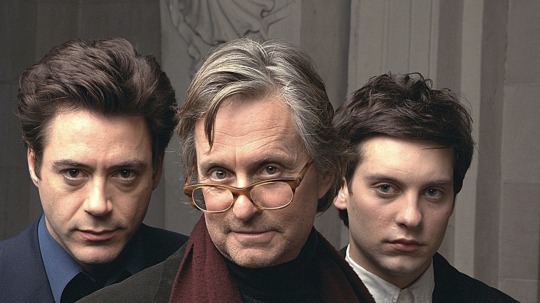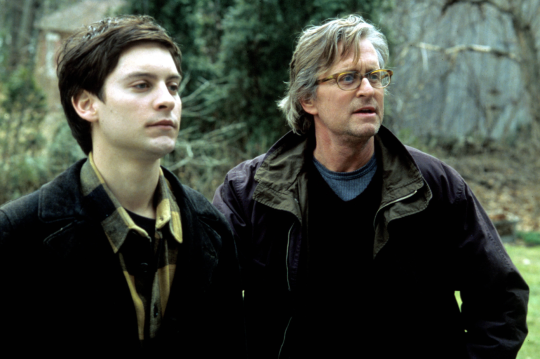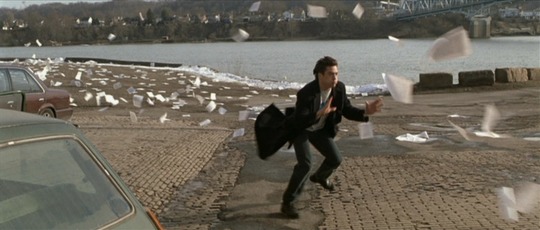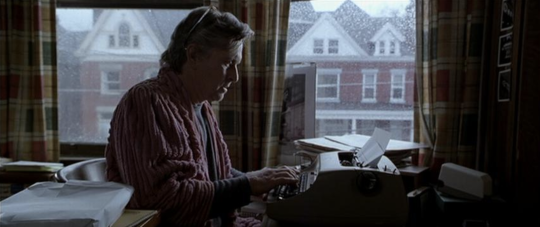Monster In A Box: What ‘Wonder Boys’ Says About The Writing Process
By Yasmina Tawil

“A picture used to be a sum of additions. In my case a picture is a sum of destructions. I do a picture—then I destroy it. In the end though, nothing is lost: the red I took away from one place turns up somewhere else.” — Pablo Picasso
///
Writing is boring. Not the act itself—actually doing it can be exhilarating, your head “vibrant with the static of unelaborated thought,” as Philip Roth once described the onset of the creative process. No, it’s watching someone write that’s boring. Next time you see someone in your office crafting an email, look at the way they just kind of stare at nothing for a while, then peck at keys, then shrug and repeat the whole thing before hitting Send and going to the bathroom. It’s always like that. Half of writing is just looking off into space, trying to get ideas to come to you, which is pretty challenging to dramatize on screen. You’re watching someone think, which means you’re trying to watch something invisible.
This is why most movies about writing are actually about typing: a character banging away at a keyboard, usually during a montage, with the finished work appearing as if wished into existence. The actual process of creating—the work of mentally panning through dirt and mud and silt to find jewels worth sharing—is an internal one, which means most films focus on the product, not the process.
Curtis Hanson’s Wonder Boys, though, manages to capture the feeling of the creative process in a way that most movies don’t, and it does so by ingeniously turning that process inside out: instead of a solitary mental experience, it’s an expressive, often public one. Instead of creating silently, we hear people thinking out loud. We get a chance to see people’s creativity fire up because we can actually hear them expressing their thoughts as they come, bouncing from one to another. “Writing” becomes “creating,” and as a result, we’re able to see new things being born, words and ideas breathed into life right in front of us.
///

Wonder Boys, directed by Curtis Hanson and released to theaters in February 2000, is based on Michael Chabon’s 1995 novel, which was in turn inspired by the life of novelist Chuck Kinder. Kinder was a professor at the University of Pittsburgh, where Chabon was one of his students, and he was working on a manuscript for a novel that, at one point, stretched to three volumes of 1,000 pages each. That idea—of a writing professor pouring himself into a monster of a book with no end in sight—became the inspiration for Chabon’s character of Grady Tripp, a literature professor who hasn’t published a book in years but who’s working on a massive novel that he can’t seem to corral. Grady, played by Michael Douglas in the film, finds himself at a crossroads as he works on his bloated book, balances his relationship with a married colleague (Frances McDormand), nurtures a pair of students (Tobey Maguire and Katie Holmes), and fends off the predatory capitalistic advances of his agent (Robert Downey Jr.), all while navigating a weekend-long book festival hosted by his university.
Hanson has a few advantages, though, thanks to Chabon’s story and a smart script from Steve Kloves (writer-director of The Fabulous Baker Boys). The movie isn’t about Grady’s work on his novel as much as it is about his shambles of a life, and how his stalled-out art is a reflection of his personal inability to make choices. One brief scene of Grady working on his book, narrated so we can hear his style, is done primarily to stress the length of Grady’s manuscript. (Typing the page number in the corner, he taps three numeric keys, then checks his work and adds a fourth, sighing.)
But the other advantage is that Hanson gets to visually represent the cerebral. The movie is about creative people inspiring each other—Grady, feeling lost and alone, draws on the energy of his gifted student, James Leer (Maguire)—and we get to see that firsthand throughout the film as Grady and other writer characters ponder the inner lives of strangers around them. There’s an outstanding scene early on where Grady is meeting up with his agent, Terry (Downey), and James at a bar, and Grady and Terry get to riffing on the personal history of a man they spy at another booth. The whole clip is worth watching, but the section in question kicks in around the 2:30 mark below:
All that Grady, Terry, and James have to do is see this man in the bar to start imagining whole fictive universes for him: a name, an occupation, a troubled past. This, the movie says, is the creative process, which means that this is what it is to write: you find yourself lit by an energy you cannot name, making reality out of imagination.
Crucially, too, Hanson doesn’t fawn over Grady or any of the other characters who improvise made-up lives for people. There’s no groveling sense of watching a genius at work; no one ever says to Grady, “You’ve cracked it wide open.” Rather, there’s a sense of joyful chaos, of not quite knowing what idea will come next, that more closely approximates the creative experience. By having the creation be spoken in dialogue, we not only get to hear the ideas come to life, but we get a chance to see how these characters drive, inspire, and relate to each other. When Grady and Terry find themselves at a loss for ideas, only to have James come through with a poetic backstory for the stranger they’ve dubbed “Vernon Hardapple,” it’s not just a representation of the creative process, but a narrative moment that shows James’s skill in comparison with his teacher’s. And it all happens in about sixty seconds.
///

If it’s true that creation and destruction are related, though, then any depiction of artistry would have to also honestly reckon with that sense of loss that comes with having missed out on something big. Wonder Boys has that, too. There’s a counterpoint to the bar scene later in the film, after Grady’s suffered a literary and personal tragedy that robs him of the only copy of his manuscript. Asked what the book was about, Grady’s unable to answer anything besides “I don’t know”; when asked why he was writing something he can’t even describe or explain, he simply says, “I couldn’t stop.”
This is where the film digs even deeper into its exploration and understanding of the writing life, and of the creative process in general. It understands the obsession that borders on madness that can drive people to create, and can keep them trapped in a place of chaos out of service to an ideal they think they have to serve. The best thing for Grady would be for this behemoth of a book to be taken away from him, but he can’t see that because he’s too deep into it. He’s enslaved to the idea of the thing instead of the thing itself, so he keeps writing in hopes of finding a way out, not realizing he’s just burying himself in more pages.
His loss of the manuscript is a true blow, and a genuinely jarring and somber moment in a film that until then has mostly flirted with droll dramedy, but this moment of destruction becomes Grady’s moment of creation and renewal. He’s able to let go, to move on, and most importantly, to begin making the choices and commitments in his life that he was refusing to make. His relationships heal, his creativity returns, and life resumes humming merrily along.


